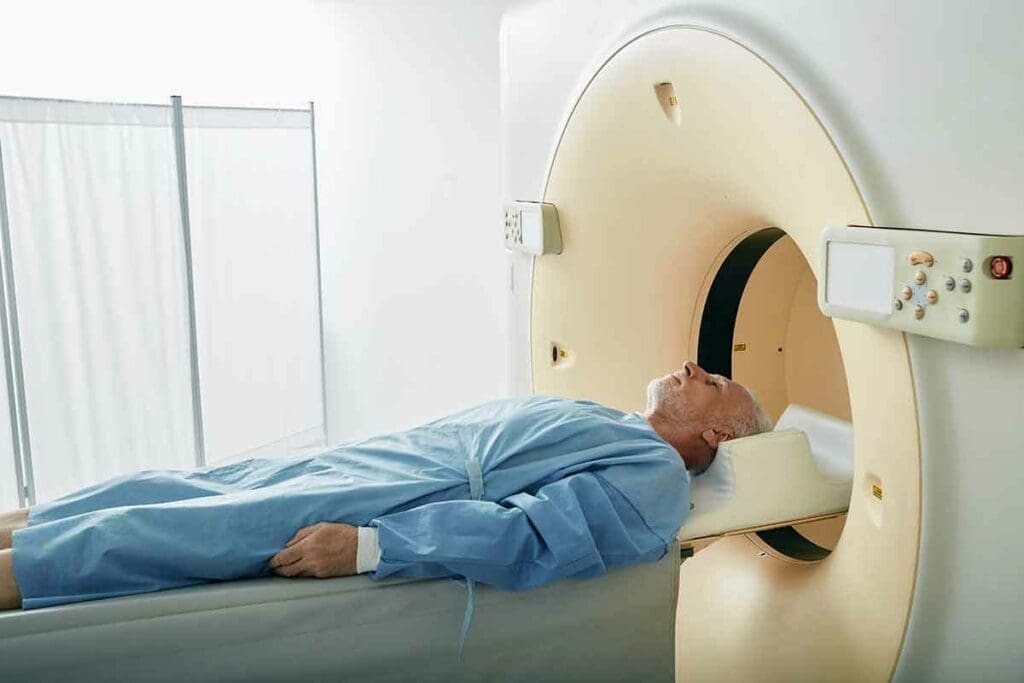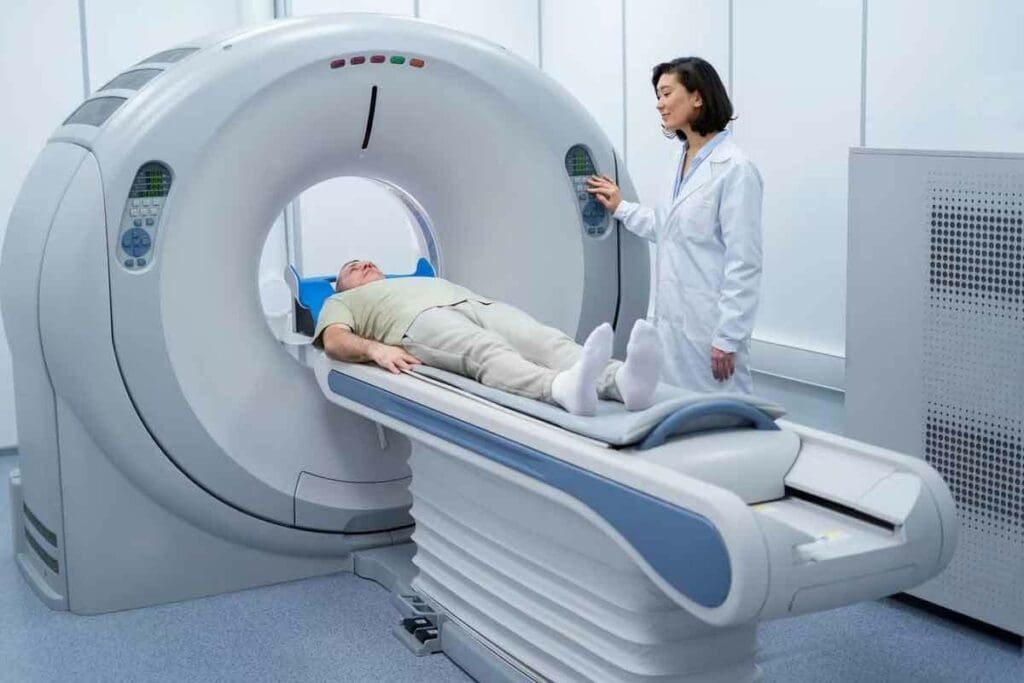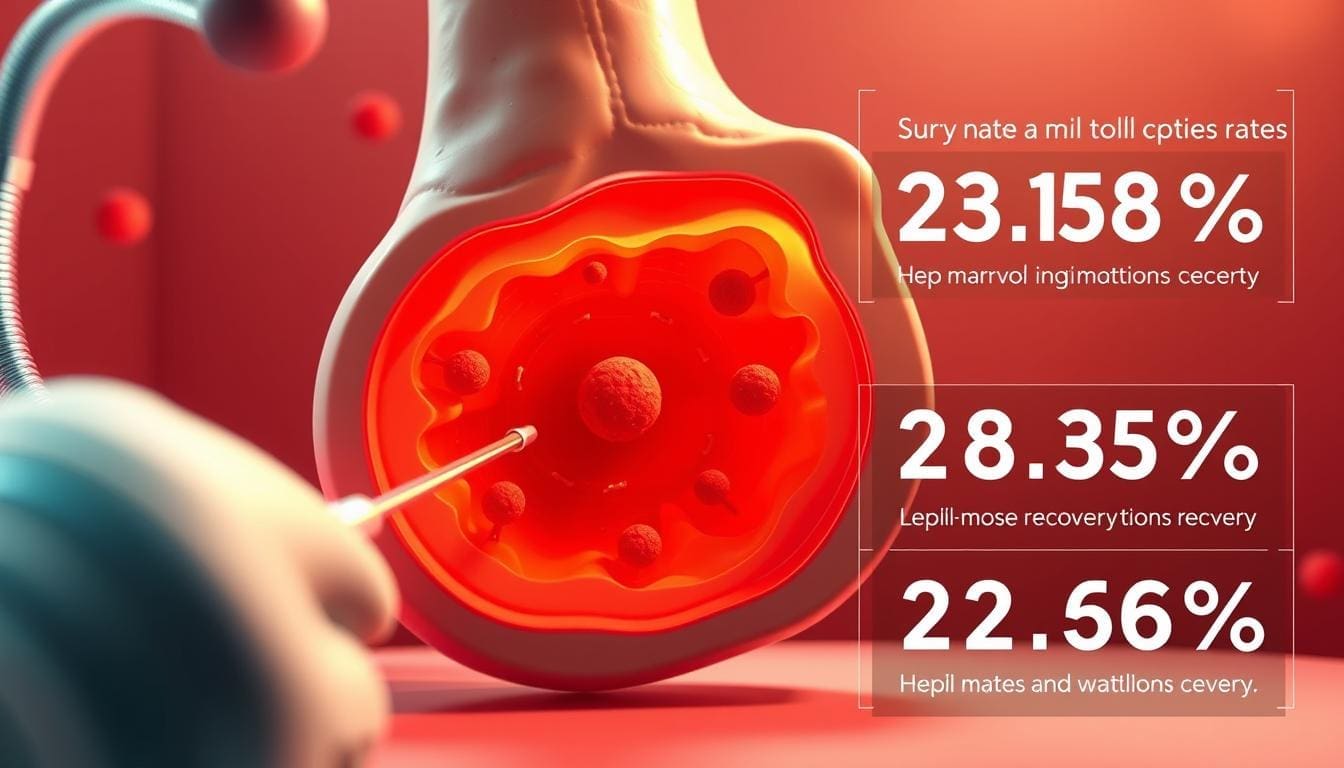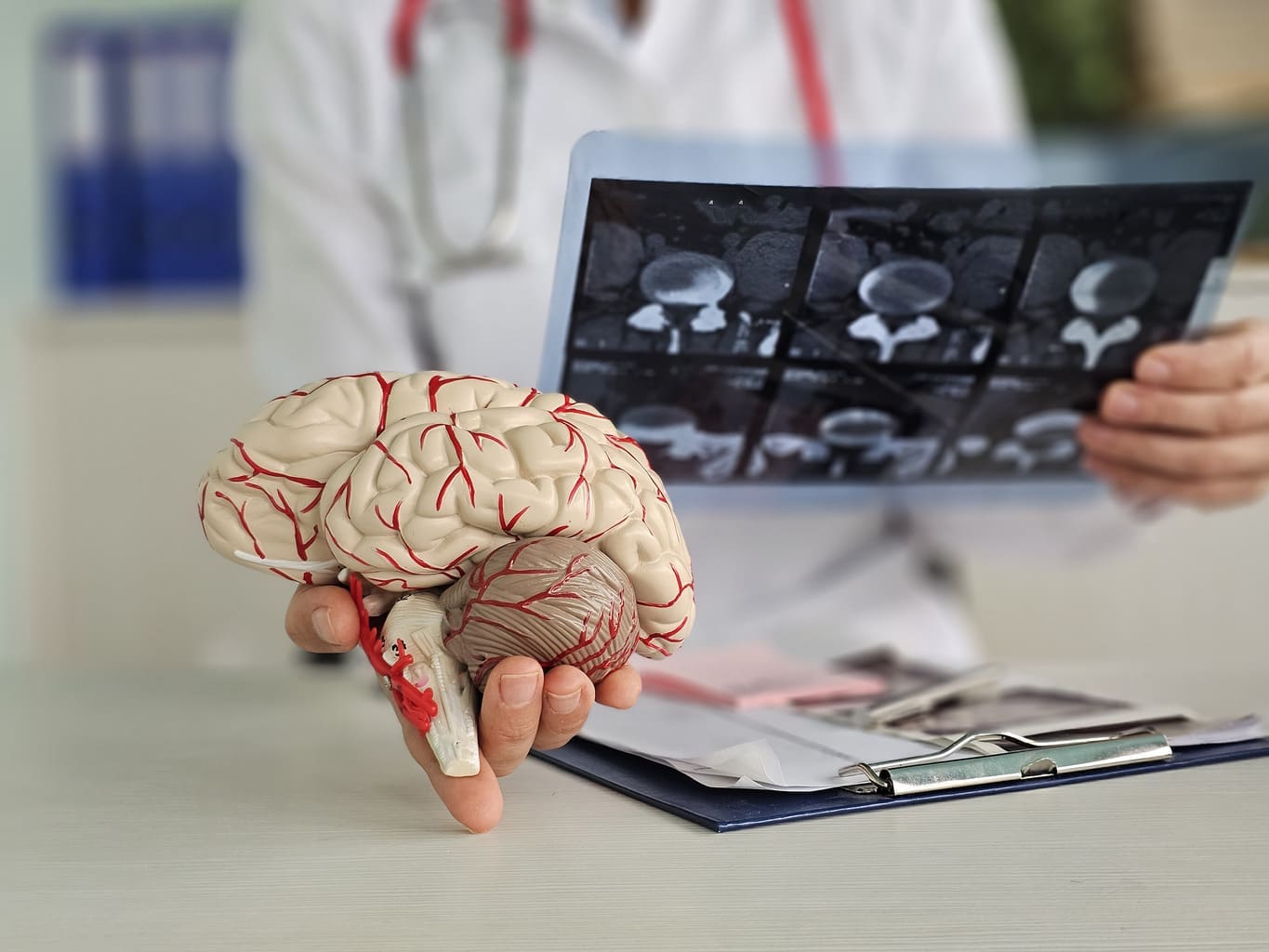Last Updated on November 27, 2025 by Bilal Hasdemir

Waiting for CT scan results can be very stressful, even more so when cancer is a worry. At Liv Hospital, we understand the importance of a quick and accurate diagnosis. A CT scan for cancer is key in spotting and tracking cancer growth.
We employ cutting-edge imaging tech for accurate results. Usually, CT scan results are ready in 12-48 hours. But this time can change based on a few things. Our team is here to offer compassionate care and support every step of the way.
Key Takeaways
- CT scans are a vital tool for cancer detection and monitoring.
- Results are typically available within 12-48 hours.
- Liv Hospital uses advanced imaging technology for precise diagnosis.
- Our team provides compassionate care and support throughout the process.
- Timely diagnosis is critical for effective cancer treatment.
Understanding CT Scans for Cancer Detection

CT scans are key in fighting cancer. They give detailed images of the body’s inside. These scans help find and track different cancers, aiding in early detection and treatment.
What is a CT Scan and What Does CT Stand For?
A CT scan uses computer ttechnologyand X-rays to make detailed images. “CT” means Computed Tomography. It lets doctors see inside the body without surgery, showing organs, bones, and soft tissues.
How CT Scans Work to Detect Abnormal Tissues
During a CT scan, you lie on a table that moves into a doughnut machine. The machine takes X-rays from all sides. Then, a computer makes detailed images from these X-rays.
This helps doctors spot abnormal tissues like tumors. They can see how big they are and where they are. This info is key for planning treatment.
Types of Cancer Commonly Detected by CT Imaging
CT scans can find many cancers, like lung, liver, pancreatic, and colorectal. They’re great for spotting tumors in the belly and pelvis. They also check if cancer has spread to lymph nodes or other organs.
| Cancer Type | CT Scan Utility |
| Lung Cancer | Highly effective for detecting tumors and assessing lymph node involvement |
| Liver Cancer | Useful for identifying tumors and evaluating liver damage |
| Pancreatic Cancer | Helps in detecting tumors and assessing vascular involvement |
| Colorectal Cancer | Effective for staging and assessing the spread of the disease |
Knowing how CT scans work helps patients understand the diagnostic process. This knowledge can reduce anxiety about cancer diagnosis and treatment.
The Typical Timeline: How Long Does It Take for CT Scan Results

The time it takes to get CT scan results varies. Knowing these times can help manage your expectations and reduce anxiety.
Standard Processing Times in the United States
In the United States, CT scan results can take a few hours to several days. For non-emergency cases, you might wait 24 to 48 hours. But, this can change based on the facility and the scan details.
Urgent cases get priority. Results can be ready in a few hours or less in emergencies. For example, in emergency rooms, radiologists quickly interpret scans, and results are shared with the team quickly.
Factors Affecting Result Timeframes
Several things can affect how long it takes to get CT scan results. These include:
- The type of CT scan performed (e.g., with or without contrast)
- The urgency of the case (emergency vs. routine)
- The workload and staffing of the radiology department
- The need for additional imaging or consultations
For example, a CT scan with contrast might take longer to interpret. Also, cases needing specialist consultations can delay results.
We know waiting for CT scan results can be tough. By understanding what affects result times, patients can better prepare for their diagnostic journey.
Emergency vs. Routine CT Scan Result Timelines
CT scans for cancer detection have different timelines based on urgency. Emergency cases get results faster than routine ones. This is because of the urgency in emergencies.
Expedited Results in Critical Situations
In emergencies like severe trauma or critical illness, CT scan results are fast. Radiologists review these results within minutes or hours. This quick turnaround is key totimely treatment in life-threatening situations.
Standard Waiting Periods for Non-Urgent Cancer Screening
For non-urgent cancer screening, results take longer. Standard processing times usually range from 24 to 48 hours. This waiting period can cause anxiety for patients.
Inpatient vs. Outpatient Result Delivery
CT scan results delivery varies for inpatients and outpatients. Inpatients get results quickly because they’re under constant care. Outpatients may wait a bit longer as results are first shared with their doctor.
Knowing these differences helps manage patient expectations. Whether it’s an emergency or routine scan, understanding the process can ease anxiety. It prepares patients for what’s next.
The CT Scan Process from Start to Results
A CT scan is a detailed process. It includes getting ready, the scan itself, and analyzing the images. We’ll guide you through each step to understand what happens during a CT scan for cancer detection.
Pre-Scan Preparation Requirements
Before a CT scan, you need to prepare. Patients must remove metal jewelry or objects that could get in the way. You might also need to wear a hospital gown to avoid clothing artifacts in the images.
In some cases, contrast material is given to make certain areas more visible. Your healthcare provider will tell you if you need to prepare by fasting or avoiding certain medications.
- Remove metal jewelry and objects
- W..ear a hospital gown if required
- Follow instructions for contrast material administration
- Adhere to any dietary or medication restrictions
During the Scan: What Actually Happens
During the scan, you’ll lie on a table that moves into a large machine. The scan is usually quick, lasting just a few minutes. You’ll need to stay very quiet and might be asked to hold your breath at times.
The CT scanner uses X-rays to take detailed pictures of your body’s inside. The person running the scanner will be in another room but can talk to you through an intercom.
Post-Scan Image Processing and Analysis
After the scan, the images are worked on and checked by a radiologist. This step is key tofinding any cancer signs. The radiologist looks for any unusual areas that might need more tests.
- The images are made clearer for better viewing
- A radiologist looks at the images for any issues
- The findings are written down in a detailed report
- The report is then given to your doctor
Knowing about the CT scan process can make you feel less nervous. By understanding what happens, you can prepare better for the test and the next steps in your cancer detection journey.
Contrast vs. Non-Contrast CT Scans: Impact on Result Times
CT scans are key in finding cancer. They come in two types: contrast and non-contrast. Each affects how long it takes to get results. The choice depends on the cancer type, patient history, and what the doctor needs to see.
How Contrast Agents Affect Processing Time
Contrast agents make CT scan images clearer. They highlight certain body parts, helping doctors spot problems. But, ey add hours to result times because images need careful review.
Studies show contrast CT scans take longer. This is because they show detailed information that needs thorough checking.
Will a CT Scan Without Contrast Show Cancer?
A CT scan without contrast can find some cancers, like big ones. Butit might miss smaller tumors or certain cancer types.
Often, a non-contrast scan is the first step. If it finds something, a contrast scan might follow for more details.
How Long to Get Results from a CT Scan with Contrast
Getting results from a contrast CT scan varies. It depends on the case’s complexity, the radiology team’s workload, and whether it’s urgent or routine.
Typical Result Times for CT Scans with Contrast:
| Setting | Typical Result Time |
| Emergency | Within 2-4 hours |
| Routine Outpatient | 24-48 hours |
| Inpatient | Within 24 hours |
Patients should talk to their doctor about when they’ll get their results.
The Role of Radiologists in CT Scan Result Timing
It’s important for patients to know how radiologists affect CT scan resultg. Radiologists are doctors who use imaging, like CT scans,, to find and treat diseases. They play a big part in cancer diagnosis.
The Interpretation Process for Cancer Detection
Reading CT scans is a detailed task. Radiologists look at body images to find cancer signs. They also figure out how far the disease has spread. This helps decide treatment plans.
Specialist Consultations and Second Opinions
When a diagnosis is hard or unclear, radiologists might ask for more help. They might get a second opinion or consult with specialists. This teamwork helps make sure patients get the right diagnosis.
Communication Between Radiologist and Referring Physician
Good communication between radiologists and doctors is key. Radiologists write detailed reports of their findings. These reports help doctors talk to patients about what’s next in their care.
Waiting for CT scan results can be very stressful for patients. Knowing how radiologists help with diagnosis can make patients understand the process better. It shows how important accurate and quick reporting is.
The Role of Radiologists in CT Scan Result Timing
Radiologists are key in analyzing CT scans for cancer. They use their skills to understand complex images. This is vital for finding cancer and planning treatment.
Interpretation Process for Cancer Detection
CT scans are analyzed for signs of cancer. Radiologists look closely at images to spot cancerous tissues. They use special agents to see more clearly.
Radiologists also think about the patient’s health history. This helps make sure the diagnosis fits the patient’s needs.
Specialist Consultations and Second Opinions
In tough cases, radiologists might ask for more help. They work with other experts to double-check their findings. This ensures patients get the best care possible.
Communication Between Radiologist and Referring Physician
Good communication is key between radiologists and doctors. Radiologists share detailed reports with doctors. Doctors then use this info to plan treatments.
Together, radiologists and doctors make sure patients get the care they need. This care is from start to finish.
Hospital vs. Outpatient Imaging Centers: Differences in Result Times
CT scan results can differ a lot, depending on where the scan is done. This is mainly because of how hospitals and imaging centers work differently. Each has its own way of doing things.
Hospital Processing Workflows
Hospitals have more complex systems because they offer many services at once. When you get a CT scan at a hospital, it’s part of a bigger plan to figure out what’s wrong. This can make it take longer to get your results because doctors need to look at everything together.
In hospitals, the radiology team works with many other doctors and departments. This means your CT scan images might be seen by lots of people. While this helps with your care, it can also slow things down because of all the coordination needed.
Private Imaging Center Timelines
Private imaging centers focus only on scans and reading them. This makes them faster at getting results back to you. They’re good at what they do because they don’t have to deal with all the hospital stuff.
At private centers, you’ll usually get your results quicker because they have doctors just for reading scans. This is great if you need to know what’s going on fast so you can get treated right away.
Academic Medical Centers vs. Community Hospitals
Even among hospitals, there’s a big difference in how fast you get your results. Academic centers, which do research and teach, might take longer. This is because they deal with very complex cases and have to teach docto,,rs too.
Community hospitals are simpler and might get your results back faster. But, they’re not as quick as private imaging centers. Both hospitals, though, take longer than centers that just do scans.
Can a CT Scan Diagnose Cancer Definitively?
CT scans are great for finding possible cancer signs. But, they can’t always tell for sure. They show where tumors are and if they’ve spread, but there are limits.
Limitations of CT Scans in Cancer Diagnosis
CT scans can’t always tell if a tumor is cancerous. They spot abnormal tissue masses, but more tests are needed to confirm cancer. Small tumors or those in hard-to-reach places might not show up.
Also, CT scans use radiation. This is safe most of the time, but is something to think about, like for young patients or when scans are needed again.
When Additional Testing is Required
If a CT scan shows something odd, more tests are usually needed. These might include:
- Biopsies to look at tissue samples
- More imaging like MRI or PET scans
- Blood tests for tumor markers
These extra steps help confirm cancer, figure out what type it is, and its stage.
The Role of Biopsies After Suspicious CT Findings
After a CT scan shows something suspicious, a biopsy is often next. It takes a tissue sample for a closer look. This step is key for a clear cancer diagnosis, as it lets experts check the tissue’s cells up close.
The path from CT scan to diagnosis can be complex and take time. But it’s a vital process for getting the right treatment.
Insurance and Administrative Factors Affecting CT Result Times
Getting CT scan results is more than just medical work. It also means dealing with many administrative steps. This can make the wait time stressful, with many factors playing a role.
Insurance Pre-authorizations and Their Impact
Before a CT scan, getting insurance pre-authorizations is key. It checks if your insurance will pay for the scan. Data shows that this step can really slow down when you get your results. It can take anywhere from a few days to weeks.
Here’s a table showing how insurance pre-authorizations affect wait times:
| Pre-authorization Timeline | Average Waiting Period | Percentage of Cases |
| Less than 3 days | 3-5 days | 20% |
| 3-7 days | 7-10 days | 40% |
| More than 7 days | 10-14 days | 40% |
Medical Records Coordination Between Facilities
It’s important for medical records to flow smoothly between facilities for quick CT scan results. If records are missing, it can cause delays. We’ve seen how better coordination can cut down wait times.
A study showed that using electronic health records can speed up CT scan results by up to 30%. This shows how important it is to have efficient systems.
Referral Requirements and Specialist Availability
Referrals and specialist availability also play a part in wait times. Sometimes, you need a doctor’s referral to see a specialist for a CT scan. The specialist’s schedule can affect how fast you get your results.
Healthcare providers are trying to improve scheduling and communication. They aim to make the wait time shorter and get results to patients faster.
Digital Access to CT Scan Results: Modern Timeframes
Digital technology has changed how we get CT scan results. Now, thanks to digital health records, patients can easily and quickly get their medical imaging results.
Patient portals are a big part of this change. These online platforms let patients safely see their medical records, including CT scan results, from anywhere with internet.
Patient Portals and Electronic Health Records
Patient portals work with electronic health records (EHRs). EHRs keep a patient’s medical history online. This lets patients see their CT scan results and other important medical info together.
Using patient portals for CT scan results has many benefits:
- Convenience: Access results from anywhere, at any time
- Timeliness: Get results faster than by mail
- Organization: See results with other medical records
Direct Access vs. Physician Review First
There’s a debate on whether patients should see their CT scan results directly or if a doctor should review them first. Some places let patients see results online, while others need a doctor to check them first.
Direct access is quick but might worry patients if they don’t understand the results. Doctor review adds context but might slow down getting the results to patients.
Legal Requirements for Result Disclosure
There are laws about when and how to share CT scan results. In the U.S., HIPAA lets patients see their medical records, including imaging results.
Healthcare providers must share results quickly but also follow the law. This balance is key.
Digital tech keeps getting better, so we’ll see more ways to get CT scan results. With tools like patient portals and EHRs, healthcare can improve patient care and outcomes.
What Happens After Receiving CT Results for Suspected Cancer
After getting CT scan results for suspected cancer, the next steps are key for your treatment. This time can be stressful and full of questions. We’ll guide you on understanding your radiology report, the importance of follow-up appointments, and when to seek a second opinion.
Understanding Your Radiology Report
Your radiology report details what your CT scan found. It’s not a diagnosis but a description of what the radiologist saw. Key components of the report include:
- A description of the scanned area
- Any abnormalities detected
- The radiologist’s impression or conclusion
When you review your report, look for sections on any lesions or suspicious areas. The size, location, and characteristics of these findings are key for your care.
Follow-up Appointments and Next Steps
Your healthcare provider will schedule a follow-up after your CT scan results. They may recommend:
- Additional imaging tests
- A biopsy to confirm cancer
- Consultations with specialists
- Treatment options if cancer is confirmed
It’s important to attend these appointments and ask questions. This includes your condition, treatment options, and what to expect.
When to Seek a Second Opinion on CT Interpretation
In some cases, a second opinion on your CT scan can offer clarity or confirm findings. You might consider this if:
| Reason for Second Opinion | Description |
| Unclear or Ambiguous Results | If the initial report is unclear or you’re unsure about the findings. |
| Rare or Complex Cases | If your condition is rare or complex, a second opinion can offer specialized insights. |
| Personal Preference | If you want additional reassurance or have concerns about the initial interpretation. |
Talking to your primary care physician can help decide if a second opinion is right for you.
Conclusion
We’ve looked at what affects the time it takes to get CT scan results for cancer. Things like the type of scan and where it’s done matter a lot. Knowing this can help patients feel more at ease and informed about their diagnosis.
Recent studies show that knowing about the process can really help patients relax. The time it takes to get CT scan results can vary. In the US, it can be anywhere from a few hours to a few days.
In short, getting CT scan results quickly and accurately is key for fighting cancer. Understanding the CT scan process helps patients on their diagnosis path. It’s also vital for clear communication between doctors and patients about results and what comes next.
FAQ
What is a CT scan and what does the “CT” in CT scan stand for?
A CT (Computed Tomography) scan is a medical test. It uses X-rays and computers to create detailed images of the body. The “CT” means Computed Tomography.
Can a CT scan detect cancer?
Yes, CT scans can find different types of cancer. They show abnormal growths, tumors, or areas that need more checks.
How long does it take to get CT scan results for cancer detection?
Getting CT scan results can take a few hours to days. It depends on the facility, scan urgency, and case complexity.
Will a CT scan without contrast show cancer?
Sometimes, a CT scan without contrast can spot cancer. But, contrast agents make certain tissues and issues clearer, helping find cancer better.
How long to get results from a CT scan with contrast?
CT scan results with contrast take about the same time as without. Contrast doesn’t slow down results but adds extra steps.
Can a CT scan diagnose cancer definitively?
CT scans can spot cancer-like areas, but they’re not always sure. More tests, like biopsies, are needed to confirm cancer.
What happens after receiving CT results for suspected cancer?
After getting CT results, your doctor will talk about them with you. They’ll explain what they mean and what to do next, like more tests or treatment.
How do I understand my radiology report?
Radiology reports are detailed about your CT scan. Your doctor will explain them to you. Ask for help if you don’t understand.
When should I seek a second opinion on CT interpretation?
If you’re unsure about your diagnosis or treatment, get a second opinion. A specialist can give you more information to help you decide.
How do patient portals and electronic health records affect access to CT scan results?
Patient portals and electronic health records let you see your CT scan results online. You can get them quickly, helping you stay involved in your care.
Are there legal requirements for disclosing CT scan results?
Yes, laws require doctors to share medical results, like CT scans, with patients. These laws vary but aim to ensure timely and proper communication.
Referencers
Lacson, R., Prevedello, L. M., Andriole, K. P., O’Connor, S. D., Roy, C., Gandhi, T., & Khorasani, R. (2022). Factors associated with turnaround time in CT and MRI interpretation. Journal of the American College of Radiology, *19*(1), 122-129. https://www.ncbi.nlm.nih.gov/pmc/articles/PMC8744297/






